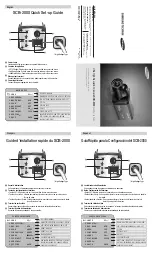
7(22)
Servodan A/S | Tel +45 7442 4726 | Fax + 45 7442 4035 | [email protected] | www.servodan.com
41Y731_03_R2_131112CWH
Presence detector KNX, 41-731
Use
Presence detector KNX 360° is in assembly with an integrated
connection to the KNX bus, and is supplied via the KNX bus.
The detector is designed for indoor installation and has a built-in
light sensor and IR receiver for use in offi ces, in schools, public
buildings or private homes.
The KNX presence detector can be integrated into solutions
with all other KNX system components for the control of the
zoned lighting with dimming as a function of incident daylight,
plus control of windows, blinds, integration with the HVAC
system, lighting scenarios, etc. The 360° detection range can
be divided into three sectors A – B – C, each comprising 120°.
The sensitivity can be adjusted either collectively for all sectors,
or individually for each. The sensor is to be programmed using
ETS4 software.
Up to eight lighting scenes can be set up for use in e.g.
conference rooms; the lighting scenes can be activated either
by pressing the switch or via the IR remote control (41-930
accessory).
Installation
Location:
The detector responds to movement and heat in relation to the
surroundings. Avoid placing the detector close to heat sources
such as cookers, electric radiators or ventilation systems, or
moving objects such as hanging mobiles etc. This may cause
unwanted activation.
Fig. 1.
Range:
The recommended installation height for this detector is 2–3.4 m.
2.5 m is the optimal installation height. At this height the detector
has a range of Ø24 m on ground level (without lens cover).
Fig. 2.
Extending the coverage area:
It is possible to increase the coverage area by connecting
multiple presence detectors confi gured as Master/Slave.
All presence detectors have the same range.
To achieve complete coverage when using several detectors,
it is recommended that an overlap of approximately 30% be
employed.
Fig. 3.
Installation:
The presence detector is designed for installing directly on
ceilings.
Fig. 4.
Connection:
The detector connects to the KNX bus.
Fig. 5.
Addressing:
In order to be able to program the detector using the ETS4
software, the detector’s address must be entered.
This can be done in the following ways:
1: Activate the programming button on the bottom of the
detector.
Fig. 6.
2: Activate the programming button located under the cover of
the detector part.
Fig. 6.
3: Activate the “Prog.” button on IR remote control 41-930
(accessory) when it is unlocked.
Fig. 7.
Setting
Factory setting:
Application: Corridors/stairwells.
Daylight zone: 1
Function: Stand-Alone
Manual zone: Not selected
Programming
Programming:
In addition to pre-programmed applications, it is possible to use
custom programming developed using the ETS4 software.
Using Basic programming, the detector can be programmed to
function as a:
-
Stand-Alone
-
Master
-
Slave
In “Stand-Alone” mode the detector controls the room alone and
is not linked to other detectors. Input and Output objects are
connected to the detector.
The detector is supplied with a lens cover –
this can be adjusted or removed for correct coverage.
41Y731_03_R2_131112CWH
GB
User guide








































